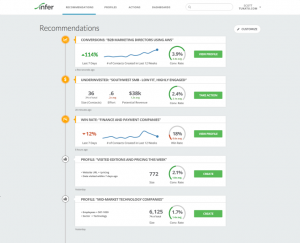
Learn how to blog for business in this in-depth guide.
Did you know most consumers would rather learn about your company through content like an informative blog post than through an advertisement? And companies that actively blog on a regular basis typically receive more traffic from search engines? As you can see, blogging for business is an important part of a company’s content marketing strategy as it will help:
- Boost your company’s visibility online through search engine optimization (SEO)
- Position you and your business as a go-to expert in your field
- Give you access to a global audience
- Establish credibility for your potential consumers
- Amplify awareness and recognition of your brand
To help your business succeed with blogging, we have put together this helpful guide, which includes information on creating topics, writing your posts, incorporating SEO best practices and promoting your articles. Let’s dive in!
How To Develop Powerful Business Blogging Topics
If blogging for business is part of your content marketing strategy, you may find it difficult to constantly develop new topics. A strong topic needs to be
created with the reader in mind; make it useful, timely, informative and simple.
The first step to coming up with new blog topics is to brainstorm. Set aside time each quarter, and don’t be afraid to ask a friend or colleague for help if you need some fresh ideas. Also, make sure you keep a notebook handy or a file on your phone for ideas; you never know when inspiration will hit!
Create an editorial calendar to clearly lay out your blog topic ideas and develop regular features, such as a monthly product review or bi-weekly recaps of industry news. By planning a quarter, half-year
or a full year at a time, you can see the overall structure of your content topics. Looking ahead will also allow you to include upcoming events important to your business, industry and community.
Still stuck coming up with topic ideas for your business’s blog? Here are a few additional ways to find inspiration:
- Conduct and review keyword research. Are there any keywords that jump out as topics you w

ould like to cover or teach your audience about?
- Look at your website’s analytics to see which posts have been popular. Come up with a new angle to the same topic or combine a few older posts to create a new one. If you decide to combine older articles, don’t forget to redirect them to the new post so you don’t hurt your SEO efforts.
- Set a Google Alert with industry keywords, then scan the headlines for inspiration; you can also use this to pull several articles together into a roundup type of post.
- Think about problems your readers face and write a post with suggestions for solving those issues.
It also helps to change up the format of your blog posts. For example, in one post you could create a list post, where you feature a bulleted list of helpful ideas or tips for you readers. Then, in the next post you could write a “how-to” or do-it-yourself article that showcases your insight, tips and tricks. You can also interview industry leaders, employees or write a post of curated content – just make sure you credit original sources.
The Anatomy Of A Strong Article When Blogging For Business
Now that you’ve come up with a variety of interesting topics for your business’s blog, it’s time to think about how to make your posts powerful for both your readers as well as search engines.
- Spend time on the title. Since the title is the first thing your audience sees in relation to your post, it’s what hooks them into reading. A helpful tactic to use when writing your title is to save it for last so it forms naturally based on the content you wrote about. As you develop your title, make sure it includes the following elements:
- Catches your readers’ attention
- Clearly explains what the post is about
- Tells your visitors why they should care
- Is short and concise (six-13 words is ideal)
- Includes a keyword for SEO
- Includes numbers, questions and/or strong, active words
- When it comes to the content, don’t write just to write. Make sure each blog post you create for your business provides value to your readers and reflects your brand’s voice or personality. In addition to writing well with a clear message, it helps to include current statistics, trends and industry news. You can also make it timely by relating the post to current events, upcoming holidays or the time of year like the seasons. Don’t forget to make sure each blog post includes a call to action, too! Ask your readers to comment, share the post, contact you or sign up for your newsletter.
- Consider your blog post’s formatting. Strong content isn’t enough for readers’ short attention spans. Make sure your post is easy to digest by using formatting to your advantage. Include subheadings, numbered and bulleted lists, break up chunky paragraphs with quotes or images and add charts and tables to support your content.
- Include at least one visual in your blog post, if not more. Research shows, “Posts that include images produce 650 percent higher engagement than text-only posts.” Select clear, crisp high-resolution images that are engaging and related to the post’s content. Make sure you have a right to use any images you use, as well.
Blogging For Business SEO Best Practices
There is more to blogging for business than creating articles your readers will want to read and formatting them in a way that’s easy to digest. You also need to think about SEO (search engine optimization). Here are a few best practices to incorporate in your blogging efforts.
- Consider frequency. For strong SEO, it’s important to be consistent – make sure that your posts go live the same day of the week and time of day. Active blogs engage readers better, which also translates into better search engine rankings. With this in mind, make blogging for your business a priority at least once per week.
- Incorporate keywords. Not sure which keywords to use? WordStream is a useful tool for

To help your SEO make sure to do keyword research when blogging for your business.
conducting quick research. Once you have your keywords, sprinkle them throughout the post in places where it seems natural (at least every 100 words or so). To get the most out of your keywords, make sure you include them in these areas of your post:
- The title
- Subheads/section headers
- Photo captions
- Image file names
- The URL of the post
- The meta-description
- The first sentence
- The last paragraph
- Think about the length. The length of your blog and the different elements within it has a bigger impact on your SEO efforts than you would initially think. When blogging for business, keep the following length guidelines in mind for various parts of your post:
- Title: 50-60 characters, or about six-13 words.
- Body of post: The most recent research shows longer blog posts perform better (between 2,000-2,500 words), however, don’t sacrifice your quality just to hit a specific word count. Make sure all the content you include in the post adds value for your reader and is not just space filler.
- Meta description (the short summary that shows up under the title in search results): Try to get as close to 155 words as possible to describe your post. Pro-tip: Adjectives are your friend here if you’re coming up a little short.
- Formatting for SEO. Just as formatting allows your reader to digest your post easier, search engines also appreciate it when you follow certain formatting. Header tags signify to the search engines and your readers the different sections and their importance.
- The post’s title should be H1
- Main subheads should use H2
- For the remainder of your article, use H3-H6 to break up your content. Just remember to keep your audience in mind and don’t get too crazy with the different tags – it can distract from your post.
- Include internal links. Not only do internal links direct the search engines to other articles on your website, but they also help readers find more useful information you wrote!
- Use quality outbound links. By linking to other optimized websites with information relevant to your blog post, Google will recognize your website as one with strong links, boosting your ranking!
- Look at analytics. You won’t know how successful blogging for your business is unless you track the data. Install Google Analytics to get helpful information about who’s visiting various pages of your website and for how long. Use this information to help guide and shape your blogging SEO efforts.
How To Promote Your Posts When Blogging For Business
You’ve written a post with search engines and the reader in mind, now what do you do? The last step in blogging for business is to encourage your audience to read it!
- Share it on all your social media platforms. Customize each update for the followers on that specific site. For example, when you share it on Facebook, make the update more casual than when you share it on LinkedIn. Also, don’t forget to add a few relevant hashtags to make it more visible.
- Use social media advertising to your advantage and pay to promote your post to reach a broader audience. According to Hootsuite, “27% of internet users say they find new products and brands through paid social ads” and “paid social ads are the #4 way people find new products, period. Like, in life, not just online. Social ads are the runner-up after word-of-mouth, TV ads, and search engines, in that order.” It is worth your while to use social media advertising to get your post in front of a new audience.
- Share your post in appropriate discussion groups. Just make sure the group you share the post in is open to self-promotional posts! Some don’t want you to link to your own website.
- Do a simple search on Twitter on your blog post’s topic and see if others are struggling with it. If you can reply, share your post and help them out; you may find that in turn, they share your post and username with their followers.
- Dedicate a portion of your newsletter to your blog posts. Introduce them in a new and interesting way to catch the eye of your readers; don’t forget to include an image, too! If you think your article is perfect for certain customers, send it to them directly with a personal message to make them feel important.
- Syndicate your content using the RSS button on your website. This feature is a great way to automatically update your readers to new articles; it even sends it directly to their social media pages!
As you can see, blogging for business is more than just putting words on paper. When done well it has a profound impact on reaching your goals. With a little time and effort spent optimizing your articles for SEO purposes and promoting them through different avenues, you are sure to build a strong, loyal following eager to learn from and support you in no time at all.
Digital & Social Articles on Business 2 Community
(57)
Report Post








